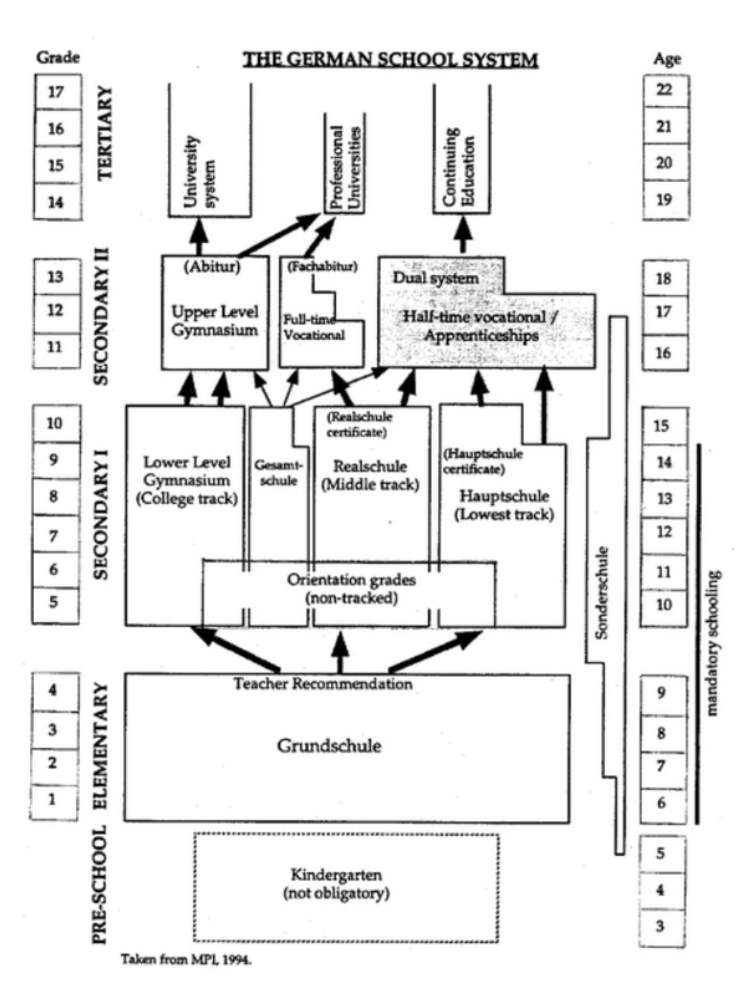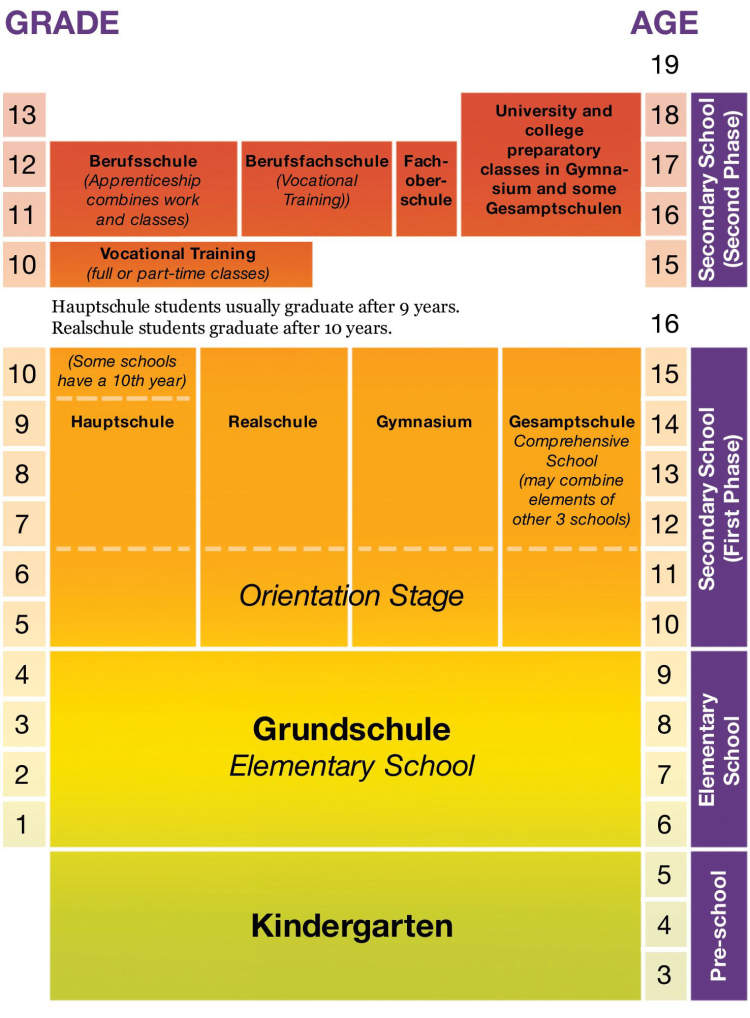Germany’s education system has a long and rich history, which has opened the way to the world-renowned higher education system that it is today. Over the past several decades, Germany has developed a robust educational structure with a variety of options for those wishing to take up studies. In this article, we will explore the German education system and how it compares to other countries around the world.
The German education system emphasizes excellence and strong academic performance from primary through to higher education. Instruction is highly structured, with teachers often providing extensive notes and feedback to students who are expected to perform well on exams and assessments. In addition, the majority of schools have strict requirements for attendance and behavior, aiming to ensure that students learning is not compromised. Germany also has a robust apprenticeship system, which is becoming an increasingly popular option for those wanting to pursue vocational training.
History of the German Education System
The German education system traces its roots all the way back to the Middle Ages. During this period, Germany was divided into many different areas and each area had its own school system. During the 18th and 19th centuries, the school system became the model for the entire nation, and in 1919 it was adopted by the Weimar Republic. After World War II, the Germany-wide German school system was once again standardized and the elementary, secondary, and tertiary levels of instruction were all established.
At the elementary level, the German system emphasizes basic subjects, such as math, science, language, music, and physical education. By the end of 6th grade, students must decide which type of school they want to attend for the remainder of their education: Hauptschule, Realschule, or Gymnasium. Students attending Hauptschule have the least academic rigor and students attending Gymnasium have the most. Each school type also has a unique specialty subject, such as an emphasis on technology, art, or music.
At the secondary level, there are many different schools, including vocational schools, specialized schools, and universities. Vocational schools offer training in specific professions, such as mechanics or construction workers. Specialized schools are for students wishing to pursue higher education in order to become teachers, lawyers, care workers, or other such occupations. Lastly, universities are for students wishing to pursue higher-level education.
Tertiary-level education is available at both colleges and universities. After completing their secondary school education, students must pass a set of examinations in order to be accepted into tertiary education. At the college level, students focus on a specific field of study, such as business, engineering, or medicine. Additionally, students can also pursue degrees at universities, such as a bachelor’s or a master’s degree.
Overall, Germany’s educational system is based on a combination of national standards and individual choices. The system provides a nationwide set of standards and, at the same time, allows individual students to pursue the topic of their choice.
Structure of the German Education System

Germany offers a variety of comprehensive school and university systems. It also offers various forms of education, such as vocational training, special education, and lifelong learning. Each of these systems has a specific purpose and is structured differently. Here is an overview of the structure of the German education system.
Comprehensive Schools
Comprehensive school is the most common type of education a child experiences. It is a school which caters to all students from ages six to sixteen. Those who reach sixteen can then choose if they would like to pursue a vocational training or higher education. It is made up of four stages:
- Primary School (Grundschule): Ages six to ten
- Secondary School (Hauptschule): Ages ten to fourteen
- Realschule: Ages ten to sixteen
- Gymnasium: Ages ten to sixteen
Vocational Training
Vocational training is the main pathway to a profession. It typically combines theoretical knowledge with practical skills, making them attractive for employers. This type of education generally starts at the age sixteen and can last from one to three years, culminating generally culminating in a state examination. Many different kinds of vocational training exist in Germany, from auto mechanics to interior designers.
Special Education
Special Education caters to students who need additional support in learning and/or developing social skills. Generally, special education is available to those from ages six to eighteen. This type of education takes place in special schools or special classrooms in primary schools. Special education includes additional therapies such as occupational therapy, physical therapy, and speech therapy.
Lifelong Learning
Throughout life, people in Germany can still pursue education, such as continuing education classes or participating in seminars. There are also a number of adult education centers around the country. The majority of courses offered at adult education centers are intended for professional development or to let people learn for enjoyable purposes. In addition, it is possible to pursue academic studies at some universities. Lifelong learning is beneficial for those looking to extend their marketability or develop new skills.
The Different Types of Schools in Germany
Germany’s education system is divided into three different types of schools. These schools differ in their curriculum, instructional methods, and language of instruction. The three types of schools are: Grundschule (primary schools), Hauptschule (lower secondary schools), and Realschule (upper secondary schools).
Grundschule (primary school) is the first level of school where children aged 6-11 learn basic educational subjects such as reading, writing, mathematics, science, and social sciences. Primary schools teach in either German, English or both languages, with some minority languages also offered in some parts of Germany.
Hauptschule (lower secondary schools) is the second stage of school for students aged 11-15. At Hauptschule, students learn a wide range of subjects including, humanities, social sciences, foreign languages, mathematics, science, sport and vocational studies.
Realschule (upper secondary schools) is the third level of school instruction. These schools are for students aged 15-18 and focus on teaching students a range of topics. Students can choose to study either business studies or sciences, with the curriculum tailored to the student’s interests.
In addition to the three types of schools mentioned above, there are also special schools that provide education to students with special needs or disabilities. These can range from schools for the blind or deaf, special needs schools, and schools for developmentally disabled students.
Conclusion
The German education system is an innovative and successful example of how to provide quality education to the public. It is characterised by its emphasis on practical and vocational training opportunities, extensive language instruction, and its thriving extracurricular activities. In addition to its comprehensive curriculum, the system also ensures that students have access to valuable experiential learning opportunities that prepare them for a successful future. Consequently, German universities remain attractive to international students, making them competitive in an increasingly globalised world.
Overall, the German education system is exemplary – providing both academic and practical training and promotion of diverse extracurricular activities. With its focus on the development of skills essential to life in the modern world, it is no surprise that it continues to draw in students from around the world. In sum, the German educational system is a prime example of how a successful academic system should be structured.




